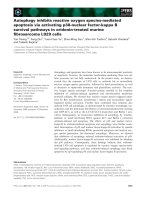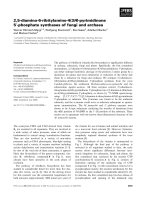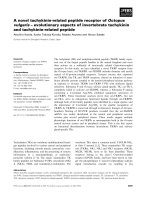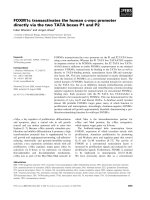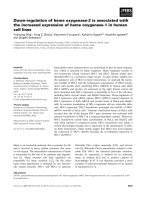Báo cáo khoa hoc:" Soy isoflavones increase preprandial peptide YY (PYY), but have no effect on ghrelin and body weight in healthy postmenopausal women" pdf
Bạn đang xem bản rút gọn của tài liệu. Xem và tải ngay bản đầy đủ của tài liệu tại đây (254.38 KB, 6 trang )
BioMed Central
Page 1 of 6
(page number not for citation purposes)
Journal of Negative Results in
BioMedicine
Open Access
Research
Soy isoflavones increase preprandial peptide YY (PYY), but have no
effect on ghrelin and body weight in healthy postmenopausal
women
Martin O Weickert*
†1,2
, Manja Reimann
†1,3
, Bärbel Otto
4
, Wendy L Hall
5
,
Katherina Vafeiadou
5
, Jesper Hallund
6
, Marika Ferrari
7
, Duncan Talbot
8
,
Francesco Branca
7
, Susanne Bügel
6
, Christine M Williams
5
, Hans-
Joachim Zunft
1
and Corinna Koebnick
1,9
Address:
1
German Institute of Human Nutrition Potsdam-Rehbruecke, Nuthetal, Germany,
2
Dept. of Endocrinology, Diabetes and Nutrition,
Charité-University-Medicine, Berlin, Germany,
3
School for Physiology, Nutrition and Consumer Sciences, North-West University Potchefstroom-
Campus, Potchefstroom, South Africa,
4
Medical Dept., University Hospital Innenstadt, Munich, Germany,
5
School of Food Biosciences, University
of Reading, Reading, UK,
6
The Royal Veterinary & Agricultural University, Research Dept. of Human Nutrition, Centre for Advanced Food Studies,
Frederiksberg, Denmark,
7
Istituto Nazionale di Ricerca per gli Alimenti e la Nutrizione, Rome, Italy,
8
Unilever Corporate Research, Colworth
House, Sharnbrook, Bedfordshire, UK and
9
Dept. of Preventive Medicine, University of Southern California, Los Angeles, USA
Email: Martin O Weickert* - ; Manja Reimann - ; Bärbel Otto -
muenchen.de; Wendy L Hall - ; Katherina Vafeiadou - ; Jesper Hallund - ;
Marika Ferrari - ; Duncan Talbot - ; Francesco Branca - ;
Susanne Bügel - ; Christine M Williams - ; Hans-Joachim Zunft - ;
Corinna Koebnick -
* Corresponding author †Equal contributors
Abstract
Background: Soy isoflavones show structural and functional similarities to estradiol. Available data indicate that estradiol and
estradiol-like components may interact with gut "satiety hormones" such as peptide YY (PYY) and ghrelin, and thus influence
body weight. In a randomized, double-blind, placebo-controlled, cross-over trial with 34 healthy postmenopausal women (59 ±
6 years, BMI: 24.7 ± 2.8 kg/m
2
), isoflavone-enriched cereal bars (50 mg isoflavones/day; genistein to daidzein ratio 2:1) or non-
isoflavone-enriched control bars were consumed for 8 weeks (wash-out period: 8-weeks). Seventeen of the subjects were
classified as equol producers. Plasma concentrations of ghrelin and PYY, as well as energy intake and body weight were measured
at baseline and after four and eight weeks of each intervention arm.
Results: Body weight increased in both treatment periods (isoflavone: 0.40 ± 0.94 kg, P < 0.001; placebo: 0.66 ± 0.87 kg, P =
0.018), with no significant difference between treatments. No significant differences in energy intake were observed (P = 0.634).
PYY significantly increased during isoflavone treatment (51 ± 2 pmol/L vs. 55 ± 2 pmol/L), but not during placebo (52 ± 3 pmol/
L vs. 50 ± 2 pmol/L), (P = 0.010 for treatment differences, independent of equol production). Baseline plasma ghrelin was
significantly lower in equol producers (110 ± 16 pmol/L) than in equol non-producers (162 ± 17 pmol/L; P = 0.025).
Conclusion: Soy isoflavone supplementation for eight weeks did not significantly reduce energy intake or body weight, even
though plasma PYY increased during isoflavone treatment. Ghrelin remained unaffected by isoflavone treatment. A larger and
more rigorous appetite experiment might detect smaller differences in energy intake after isoflavone consumption. However,
the results of the present study do not indicate that increased PYY has a major role in the regulation of body weight, at least in
healthy postmenopausal women.
Published: 14 August 2006
Journal of Negative Results in BioMedicine 2006, 5:11 doi:10.1186/1477-5751-5-11
Received: 02 June 2006
Accepted: 14 August 2006
This article is available from: />© 2006 Weickert et al; licensee BioMed Central Ltd.
This is an Open Access article distributed under the terms of the Creative Commons Attribution License ( />),
which permits unrestricted use, distribution, and reproduction in any medium, provided the original work is properly cited.
Journal of Negative Results in BioMedicine 2006, 5:11 />Page 2 of 6
(page number not for citation purposes)
Background
Several intervention studies in humans and animals sug-
gest that consumption of soy and isoflavone-rich soy pro-
tein may decrease body weight [1,2]. Postmenopausal
women with relatively high isoflavone consumption in
their normal diet showed an inverse association with
obesity in a cross-sectional study [3]. However, the pro-
tein content of soy may be at least partly responsible for
the observed effects, and the contribution of soy isofla-
vones such as genistein and daidzein remains uncertain
[4,5]. There is some evidence that may link isolated isofla-
vone consumption per se to the regulation of body weight.
Soy isoflavones show functional and structural similari-
ties to estradiol [6], mainly by binding to the estrogen
receptor β [7]. In ovariectomized mice, loss of circulating
estrogen increases body weight and fat mass, and this is
reversed by estrogen replacement [8,9]. Similar effects
have been observed in ovariectomized mice treated with
oral genistein [10,11]. Even though the role of postmeno-
pausal hormone replacement in modulating body weight
is controversial [12,13], some studies indicate that the
activation of the estrogen receptor interferes with the reg-
ulation of gut hormones commonly thought to be
involved in the regulation of food intake. Food intake
decreases during the high estrogen period in the estrous
cycle in rats, and estradiol replacement in ovariectomized
rats increased the satiating effect of the gut hormone
cholecystokinin [14]. Estrogen replacement in hysterect-
omized postmenopausal women also increased periph-
eral concentrations of the orexigenic gut hormone ghrelin
[15]. Peptide YY (PYY), a member of the neuropeptide Y
(NPY) family and another gut derived "satiety hormone",
is assumed to have potent anorexigenic properties, with
potential therapeutic use in obese humans [16]. Human
PYY has been shown to be regulated in a gender specific
manner, with higher PYY secretion in females than in
males [17]. Treatment of ovariectomized rodents with
estradiol increases the number of receptors of several neu-
ropeptides, including NPY receptors in the brain [18]. To
date, potential effects of isolated isoflavones on PYY have
not been reported, and only one study investigated effects
of isolated isoflavones on total ghrelin concentrations
[19]. In addition, no long-term randomized controlled
studies have investigated whether changes in PYY concen-
trations influence food intake in free living humans. The
hypothesis of the present study was that estradiol-like
properties of isolated isoflavones may influence PYY and
ghrelin, and thus energy intake and body weight.
Results
Results of biomarkers are given as postabsorptive concen-
trations, measured after a standardized low-fat evening
meal and after 12 h overnight fasts. P values for PYY, glu-
cose, insulin and ghrelin are given for the treatment effect
within a linear mixed model. Differences from baseline
were used as response variable after adjustment for
changes in BMI.
Dietary intake and body weight
Dietary intake was assessed at baseline and after four
weeks of each intervention arm. Macronutrient intake at
baseline was 15% of energy as protein, 34% as fat, and
47% as carbohydrate. Even though participants were
instructed to replace snacks by the cereal bars, body
weight increased moderately, but significantly, during
both intervention periods (placebo + 0.66 ± 0.87 kg, (P =
0.018); isoflavones + 0.40 ± 0.94 kg, (P < 0.001)). There
was no significant difference in body weight and body
mass index (P > 0.331) between treatments (table 1).
There were no significant differences in energy intake or
macronutrient intake, both across the treatments and
compared to baseline (wk4 - wk0; interaction treatment
vs. time, P = 0.634).
Effect of isoflavone consumption on PYY
During isoflavone consumption, PYY concentrations
increased by eight percent, and during placebo consump-
tion, PYY concentrations decreased by four percent (P =
0.010 for treatment differences) (table 1).
Changes in PYY levels were independent of changes in
BMI, and were negatively correlated with baseline PYY (r
Table 1: Plasma PYY, body weight, and urinary isoflavone concentrations in postmenopausal women, at baseline (t0) and after 8 weeks
(t8) of isoflavone or placebo consumption (n = 34)
Isoflavones Placebo P value
1
t0 t8 t0 t8
Total PYY (pmol/L) 51 ± 2 55 ± 2 52 ± 3 50 ± 2 0.010
BMI (kg/m
2
) 24.5 ± 2.7 24.6 ± 2.7 24.5 ± 2.8 24.7 ± 2.8 0.331
Glucose (mmol/L) 5.7 ± 0.1 5.6 ± 0.1 5.7 ± 0.1 5.6 ± 0.1 0.641
Insulin (pmol/L) 37 ± 3 39 ± 3 38 ± 3 34 ± 3 0.231
Total ghrelin (pmol/L) 129 ± 12 131 ± 12 133 ± 13 123 ± 11 0.297
Data are given as mean ± SEM except for BMI which is presented as mean ± SD. BMI = body mass index.
1
P values are shown for the treatment effect within a linear mixed model. Differences from baseline were used as response variable after
adjustment for changes in BMI.
Journal of Negative Results in BioMedicine 2006, 5:11 />Page 3 of 6
(page number not for citation purposes)
= -0.67; P < 0.001). PYY concentrations were not signifi-
cantly different between equol producers and equol non-
producers.
Effect of isoflavone consumption on ghrelin
At baseline, ghrelin was significantly lower in equol pro-
ducers (110 ± 16 pmol/L) than in equol non-producers
(162 ± 17 pmol/L); (P = 0.025), independent of BMI.
However, isoflavone treatment did not affect ghrelin con-
centrations (table 1).
Other parameters
During isoflavone treatment, urinary genistein and daid-
zein excretion increased 15 fold and 24 fold, respectively.
There was no significant increase in urinary genistein and
daidzein concentrations following placebo treatment.
According to the cut-offs used in the present study [20], 50
percent of the participants (n = 17) were classified as
equol producers. Equol production increased 35 fold in
equol producers during the active treatment, compared to
an 1.7 fold increase in equol non-producers (table 2).
Plasma glucose and insulin were unaffected by isoflavone
treatment (table 1).
Power analysis
A between-treatment difference in body weight > 500 g
after 8 weeks intervention was assumed to be relevant. The
estimated power of this study was 94 percent to detect a
difference of 500 ± 900 g in body weight between treat-
ments with a sample size of 34 subjects and a significance
level of 0.05.
Discussion
Consumption of soy derived food rich in isoflavones has
been suggested to have favorable effects on energy intake
and body weight [5]. However, soy derived food is also
rich in protein, and an increased protein intake might be
responsible for the observed effects. The potential contri-
bution of isolated isoflavones to the regulation of energy
and body weight remains uncertain. In the present study,
isoflavone treatment for eight weeks did not significantly
influence energy intake, macronutrient intake, or body
weight, both across the treatments or compared to base-
line. Isoflavone treatment did not affect preprandial ghre-
lin, which seems to be in contrast to results of a previous
study that investigated effects of isoflavone treatment on
ghrelin concentrations [19]. However, the observed differ-
ences in the mentioned study are mainly due to increased
ghrelin concentrations in the placebo group rather than
altered ghrelin concentrations after isoflavone intake. In
addition, high within and between subject variations in
preprandial ghrelin concentrations have been reported,
which may lead to the detection of random effects rather
than of true treatment effects [21]. Despite unchanged
ghrelin concentrations during isoflavone treatment in the
present study, the ability of producing equol, a gut bacte-
rial metabolite of daidzein with higher binding affinity to
estrogen receptors compared with its precursor [22], was
associated with lower ghrelin concentrations at baseline.
The capability to produce equol is greatly varying between
individuals, with about 30–40% equol producers in the
Western population [22]. It is speculated that equol pro-
ducers may have an increased benefit from soy consump-
tion [20,23]. However, even though the ability of
producing equol was associated with lower ghrelin con-
centrations at baseline, ghrelin responses remained unaf-
fected during isoflavone treatment in the present study.
This indicates that equol may have a long-term suppres-
sive effect on ghrelin concentrations, which probably will
not respond to further and relatively short-term increases
of equol concentrations. In contrast to unchanged ghrelin
in the present study, isolated soy isoflavones significantly
increased plasma PYY concentrations. Given the assumed
potent anorexigenic properties of PYY [16], our data do
not suggest a major role of PYY on the regulation of body
weight. Notably, power analysis indicated that even a
moderate difference in body weight between treatments
was highly likely to be detected. Only moderate effects of
PYY on the regulation of body weight may contribute to
the explanation of controversial findings in the literature.
In humans, short-term intravenous administration of PYY
Table 2: Urinary isoflavone concentrations in postmenopausal women at baseline (t0) and week 8 (t8) of isoflavone and placebo arms
(n = 34)
Isoflavones Placebo P value
1
t0 t8 t0 t8
Genistein (nmol/L) 808 ± 134 12266 ± 852 655 ± 68 647 ± 73 <0.001
Daidzein (nmol/L) 334 ± 88 8146 ± 651 315 ± 82 223 ± 40 <0.001
Equol, (nmol/L) 154 ± 12 3040 ± 713 162 ± 15 198 ± 23 <0.001
Equol producers (n
= 17)
164 ± 11 5834 ± 749 179 ± 16 237 ± 29 <0.001
Equol non-
producers (n = 17)
143 ± 14 245 ± 16 145 ± 13 160 ± 12 <0.001
Data are given as mean ± SEM.
1
P values are shown for the treatment effect within a linear mixed model. Differences from baseline were used as response variable.
Journal of Negative Results in BioMedicine 2006, 5:11 />Page 4 of 6
(page number not for citation purposes)
[3-36] in supraphysiological [24,25], but not in physio-
logical doses [25] reduces appetite and food intake. Long-
term studies in humans are not available to date. A two
weeks continous PYY infusion in colectomized rats did
not affect food intake and body weight [26], and data
obtained from other animal studies are controversially
discussed [27]. The duration of the present study may
have been too short to detect relevant differences in body
weight. However, most studies linking physiological ghre-
lin and PYY responses to food intake investigated the
effects of only one meal. A relatively small but well per-
formed study over 16 weeks did not show an effect of
macronutrient intake and energy intake on preprandial
ghrelin [21]. It needs, however, to be emphasized that
food diaries, and not weighed food intake were used to
assess energy intake in the present study, and a more rig-
orous appetite experiment might detect smaller effects. In
addition, adaptation processes and counter regulatory
responses in other satiety hormones than total ghrelin,
such as acylated ghrelin, glucagon-like peptide (GLP-1),
or cholecystokinin may have masked detectable differ-
ences in energy intake or body weight.
Conclusion
Isoflavone treatment had no effect on energy intake and
body weight, despite significantly increased preprandial
PYY concentrations. The findings indicate that PYY is not
a major factor in the regulation of body weight. Prepran-
dial ghrelin was not affected by isoflavone consumption.
The isoflavone contents are not likely to explain the
observed beneficial effects of soy consumption on energy
intake and body weight.
Methods
Subjects
This study was part of a multi-center intervention located
in Frederiksberg (Denmark), Reading (UK), Rome (Italy),
and Potsdam (Germany). Potential effects of isoflavones
on gut satiety hormones and body weight were investi-
gated in the German population. Thirty-six healthy post-
menopausal women (age 59 ± 6 y, BMI 24.7 ± 2.8 kg/m
2
),
defined as at least 12 months since the last menstrual
cycle, were recruited by advertisement in the local media.
Thirty-four of the subjects completed the intervention.
One of the subjects was excluded because of a prolonged
respiratory infection, the other one because of start of a
treatment with an angiotensin-converting-enzyme inhibi-
tor. None of the volunteers had used hormone replace-
ment therapy for six months, antibiotics for three months,
or isoflavone, vitamin, or mineral containing supple-
ments for two months. All volunteers were non-smokers.
Parameters of renal and liver function were within normal
range. Subjects were classified as equol producers, when
equol in a 24 h urine sample exceeded 936 nmol/liter dur-
ing isoflavone treatment, which corresponds to an urinary
equol excretion of > 0.45 mg/day [20]. The study protocol
was approved by the Ethics Committee of the University
of Potsdam, Germany. All volunteers gave written
informed consent prior to the study.
Study design
This was a randomized, double-blind, placebo-control-
led, 2 × 8-wk crossover study, separated by an 8-wk wash-
out period. Subjects were invited to the metabolic unit on
6 occasions (t0, t4, and t8 on each intervention arm), after
12-h overnight fasts. To exclude potential second-meal
effects, a set low-fat evening meal (< 10 g fat) was con-
sumed the evening before each of the study days. Recipes
for the preparation of the meals were provided to the par-
ticipants. Energy contents of the meals were comparable.
Subjects were asked to consume two fruit cereal bars/d
(Health & Diet Food, Manchester, UK), one in the morn-
ing and one in the afternoon, in addition to their normal
diet. During the treatment period, cereal bars were
enriched with 2 × 25 mg isoflavones/d, with a genistein to
daidzein ratio of 2:1 ("Solgen 40", Solbar Plant Extracts,
Ashdod, Israel). Thus, isoflavone intake in the treatment
group of the present study was in the upper range of the
daily isoflavone intake in traditional Asian diets (15 – 50
mg/d) [28]. The product was tested before packaging and
during the study by HPLC, to ensure stability of the isofla-
vones [29]. Placebo did not contain any isoflavones. Each
cereal bar (40 g) had an average nutrient content of energy
(652 kJ); protein 2.6 g; carbohydrate 17.3 g; fat 8.5 g; fiber
1.8 g; sodium 0.012 g. Subjects perceived the isoflavone-
enriched and placebo cereal bars as identical in taste and
visual appearance. Habitual diet was assessed by esti-
mated 3-d food records three times during the study. Diet
diaries were completed at baseline (t0) and after 4 weeks
(t4) of each intervention arm. All food records included
two week days and one weekend day. Nutrient intake was
calculated based on the German Food and Nutrient Data
Base Bundeslebensmittelschlüssel BLS II.3 [30]. To avoid
weight gain, subjects were advised to replace snacks with
the cereal bars. Subjects kept daily records of cereal bar
consumption and well-being in a study diary. Dietary
compliance was further assessed by measurement of phy-
toestrogen concentrations in 24-hour urine [31], which
was collected at start and end of each intervention period.
Body weight was measured at each visit.
Biochemical parameters
Blood was collected in ice-chilled EDTA tubes for the anal-
ysis of glucose, ghrelin, and PYY. Following centrifugation
at 1600 g for 10 minutes at 4°C, aliquots were immedi-
ately frozen at -20°C until assayed. All samples from indi-
vidual subjects were measured in the same assay.
Immunoreactive total ghrelin was measured by a com-
mercially available radioimmunoassay (Phoenix Pharma-
ceuticals, Mountain View, CA, USA), as previously
Journal of Negative Results in BioMedicine 2006, 5:11 />Page 5 of 6
(page number not for citation purposes)
described [32]. Immunoreactive total human PYY was
measured by a commercially available radioimmunoassay
(LINCO Research, Missouri, USA), using
125
I-labeled bio-
active PYY as tracer and a PYY antiserum to determine the
level of active PYY by the double antibody/PEG tech-
nique. The PYY antibody is raised in guinea pigs and rec-
ognizes both the PYY 1–36 and PYY 3–36 forms of human
PYY. Intra- and inter-assay coefficient of variation was
5.3% and 7.0%, respectively. Insulin, and glucose, and
urinary phytoestrogens (genistein, daidzein, equol) were
analyzed as previously described [33].
Statistical analyses
Data are given as mean ± SEM, anthropometric data are
given as mean ± SD. Changes from baseline, e.g. week-8
compared to week-0 (t8-t0), were used as the dependent
variables. Data were calculated as changes from baseline
on the original scale, when normally distributed. Skewed
data where log transformed, and changes from baseline
on the log scale were calculated, and these changes now
correspond to a multiplicative change from baseline on
the original scale. Subjects were included as a random fac-
tor within a linear mixed model. Fixed effects included in
the final model were: baseline parameters, treatment,
treatment order, and changes in BMI. Further exploratory
investigation of equol group was included in the model.
Pearson's correlation coefficient was calculated between
baseline PYY and changes in PYY. Statistical analysis was
performed using SAS 8.4 (SAS Institute Inc., Cary, NC).
Abbreviations
BMI: body mass index; PYY: peptide YY.
Competing interests
This study was carried out with financial support from the
Commission of the European Communities, ISOHEART
QLK1-2001-00221. It does not necessarily reflect its views
and in no way anticipates the Commission's future policy
in this area. The authors declare that they have no compet-
ing interests.
Authors' contributions
MOW, BO, CK, and MR were responsible for data analysis
and writing of the manuscript. S B, CMW, and HJZ were
responsible for the study design and were involved in all
aspects of the study as well as manuscript review. MR, JH
and MF, and KV were involved in the collection of the
data. BO, WLH, and DT were responsible for laboratory
analysis. All authors contributed to the manuscript.
References
1. Bosello O, Cominacini L, Zocca I, Garbin U, Compri R, Davoli A, Bru-
netti L: Short- and long-term effects of hypocaloric diets con-
taining proteins of different sources on plasma lipids and
apoproteins of obese subjects. Ann Nutr Metab 1988,
32:206-214.
2. Aoyama T, Fukui K, Takamatsu K, Hashimoto Y, Yamamoto T: Soy
protein isolate and its hydrolysate reduce body fat of dietary
obese rats and genetically obese mice (yellow KK). Nutrition
2000, 16:349-354.
3. Goodman-Gruen D, Kritz-Silverstein D: Usual dietary isoflavone
intake is associated with cardiovascular disease risk factors
in postmenopausal women. J Nutr 2001, 131:1202-1206.
4. Halton TL, Hu FB: The effects of high protein diets on thermo-
genesis, satiety and weight loss: a critical review. J Am Coll Nutr
2004, 23:373-385.
5. Bhathena SJ, Velasquez MT: Beneficial role of dietary phytoes-
trogens in obesity and diabetes. Am J Clin Nutr 2002,
76:1191-1201.
6. Knight DC, Eden JA: A review of the clinical effects of phytoes-
trogens. Obstet Gynecol 1996, 87:897-904.
7. Kuiper GG, Lemmen JG, Carlsson B, Corton JC, Safe SH, van der Saag
PT, van der Burg B, Gustafsson JA: Interaction of estrogenic
chemicals and phytoestrogens with estrogen receptor beta.
Endocrinology 1998, 139:4252-4263.
8. McElroy JF, Wade GN: Short- and long-term effects of ovariec-
tomy on food intake, body weight, carcass composition, and
brown adipose tissue in rats. Physiol Behav 1987, 39:361-365.
9. Mohamed MK, Abdel-Rahman AA: Effect of long-term ovariec-
tomy and estrogen replacement on the expression of estro-
gen receptor gene in female rats. Eur J Endocrinol 2000,
142:307-314.
10. Naaz A, Yellayi S, Zakroczymski MA, Bunick D, Doerge DR, Lubahn
DB, Helferich WG, Cooke PS: The soy isoflavone genistein
decreases adipose deposition in mice. Endocrinology 2003,
144:3315-3320.
11. Kim HK, Nelson-Dooley C, Della-Fera MA, Yang JY, Zhang W, Duan
J, Hartzell DL, Hamrick MW, Baile CA: Genistein decreases food
intake, body weight, and fat pad weight and causes adipose
tissue apoptosis in ovariectomized female mice.
J Nutr 2006,
136:409-414.
12. Kristensen K, Pedersen SB, Vestergaard P, Mosekilde L, Richelsen B:
Hormone replacement therapy affects body composition
and leptin differently in obese and non-obese postmenopau-
sal women. J Endocrinol 1999, 163:55-62.
13. Augoulea A, Mastorakos G, Lambrinoudaki I, Christodoulakos G,
Creatsas G: Role of postmenopausal hormone replacement
therapy on body fat gain and leptin levels. Gynecol Endocrinol
2005, 20:227-235.
14. Geary N, Trace D, McEwen B, Smith GP: Cyclic estradiol replace-
ment increases the satiety effect of CCK-8 in ovariect-
omized rats. Physiol Behav 1994, 56:281-289.
15. Kellokoski E, Poykko SM, Karjalainen AH, Ukkola O, Heikkinen J,
Kesaniemi YA, Horkko S: Estrogen replacement therapy
increases plasma ghrelin levels. J Clin Endocrinol Metab 2005,
90:2954-2963.
16. Small CJ, Bloom SR: The therapeutic potential of gut hormone
peptide YY3-36 in the treatment of obesity. Expert Opin Investig
Drugs 2005, 14:647-653.
17. Kim BJ, Carlson OD, Jang HJ, Elahi D, Berry C, Egan JM: Peptide YY
is secreted after oral glucose administration in a gender-spe-
cific manner. J Clin Endocrinol Metab 2005, 90:6665-6671.
18. Parker SL, Carroll BL, Kalra SP, St-Pierre S, Fournier A, Crowley WR:
Neuropeptide Y Y2 receptors in hypothalamic neuroendo-
crine areas are up-regulated by estradiol and decreased by
progesterone cotreatment in the ovariectomized rat. Endo-
crinology 1996, 137:2896-2900.
19. Nikander E, Tiitinen A, Laitinen K, Tikkanen M, Ylikorkala O: Effects
of isolated isoflavonoids on lipids, lipoproteins, insulin sensi-
tivity, and ghrelin in postmenopausal women. J Clin Endocrinol
Metab 2004, 89:3567-3572.
20. Setchell KD, Brown NM, Lydeking-Olsen E: The clinical impor-
tance of the metabolite equol-a clue to the effectiveness of
soy and its isoflavones. J Nutr 2002,
132:3577-3584.
21. Paul DR, Kramer M, Rhodes DG, Rumpler WV: Preprandial ghre-
lin is not affected by macronutrient intake, energy intake or
energy expenditure. J Negat Results Biomed 2005, 4:2.
22. Manach C, Williamson G, Morand C, Scalbert A, Remesy C: Bioa-
vailability and bioefficacy of polyphenols in humans. I.
Review of 97 bioavailability studies. Am J Clin Nutr 2005,
81:230S-242S.
Publish with BioMed Central and every
scientist can read your work free of charge
"BioMed Central will be the most significant development for
disseminating the results of biomedical research in our lifetime."
Sir Paul Nurse, Cancer Research UK
Your research papers will be:
available free of charge to the entire biomedical community
peer reviewed and published immediately upon acceptance
cited in PubMed and archived on PubMed Central
yours — you keep the copyright
Submit your manuscript here:
/>BioMedcentral
Journal of Negative Results in BioMedicine 2006, 5:11 />Page 6 of 6
(page number not for citation purposes)
23. Duncan AM, Merz-Demlow BE, Xu X, Phipps WR, Kurzer MS: Pre-
menopausal equol excretors show plasma hormone profiles
associated with lowered risk of breast cancer. Cancer Epidemiol
Biomarkers Prev 2000, 9:581-586.
24. Batterham RL, Cohen MA, Ellis SM, Le Roux CW, Withers DJ, Frost
GS, Ghatei MA, Bloom SR: Inhibition of food intake in obese sub-
jects by peptide YY3-36. N Engl J Med 2003, 349:941-948.
25. Degen L, Oesch S, Casanova M, Graf S, Ketterer S, Drewe J, Beglinger
C: Effect of peptide YY3-36 on food intake in humans. Gastro-
enterology 2005, 129:1430-1436.
26. Babu M, Purhonen AK, Bansiewicz T, Makela K, Walkowiak J, Miet-
tinen P, Herzig KH: Effect of total colectomy and PYY infusion
on food intake and body weight in rats. Regul Pept 2005,
131:29-33.
27. Tschop M, Castaneda TR, Joost HG, Thone-Reineke C, Ortmann S,
Klaus S, Hagan MM, Chandler PC, Oswald KD, Benoit SC, et al.: Phys-
iology: does gut hormone PYY3-36 decrease food intake in
rodents? Nature 2004, 430:. 1 p following 165; discussion 162 p fol-
lowing 165
28. de Kleijn MJ, van der Schouw YT, Wilson PW, Adlercreutz H, Mazur
W, Grobbee DE, Jacques PF: Intake of dietary phytoestrogens is
low in postmenopausal women in the United States: the
Framingham study(1-4). J Nutr 2001, 131:1826-1832.
29. de Pascual-Teresa S, Hallund J, Talbot D, Schroot J, Williams CM,
Bugel S, Cassidy A: Absorption of isoflavones in humans: effects
of food matrix and processing. J Nutr Biochem 2006, 17:257-264.
30. Federal Institute for Health Protection of Consumers and Veterinary
Medicine: The German Food Code and Nutrient Data Base (BLS II.3): con-
ception, structure and documentation of the data base blsdat Berlin, Ger-
many: BgVV Publications; 1999.
31. Bingham SA: The use of 24-h urine samples and energy
expenditure to validate dietary assessments. Am J Clin Nutr
1994, 59:227S-231S.
32. Weickert MO, Mohlig M, Schofl C, Arafat AM, Otto B, Viehoff H,
Koebnick C, Kohl A, Spranger J, Pfeiffer AF: Cereal fiber improves
whole-body insulin sensitivity in overweight and obese
women. Diabetes Care 2006, 29:
775-780.
33. Hall WL, Vafeiadou K, Hallund J, Bugel S, Koebnick C, Reimann M,
Ferrari M, Branca F, Talbot D, Dadd T, et al.: Soy-isoflavone-
enriched foods and inflammatory biomarkers of cardiovas-
cular disease risk in postmenopausal women: interactions
with genotype and equol production. Am J Clin Nutr 2005,
82:1260-1268.


